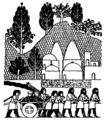Vault (architecture) facts for kids
A vault is a special kind of ceiling or roof in buildings. It's shaped like an arch and helps cover a space. Imagine a curved roof that supports itself! Vaults are a very old way to build strong and beautiful ceilings.
Contents
What is a Vault?
A vault is an architectural term for a curved structure that forms a ceiling or roof. It works like a series of arches joined together. This design helps to spread the weight of the roof down to the walls or pillars below.
How Vaults Work
Vaults are strong because of their curved shape. When weight pushes down on a vault, the force is pushed outwards and downwards. This outward push is called "thrust." Builders need to make sure the walls are strong enough to handle this thrust, or the vault could collapse.
Types of Vaults
There are many different kinds of vaults, each with its own unique look and way of being built.
Barrel Vaults
A barrel vault is the simplest type. It looks like a long tunnel or a barrel cut in half lengthwise. It's basically a continuous arch. These vaults are very strong but can make a room feel a bit dark because they don't allow for many windows.
Groin Vaults
A groin vault is made when two barrel vaults cross each other at right angles. The lines where they meet are called "groins." This type of vault is stronger than a barrel vault and allows for openings or windows in the walls below.
Rib Vaults
Rib vaults became popular in Gothic architecture. They have stone ribs that act like a skeleton, supporting the curved panels of the ceiling. These ribs help direct the weight to specific points, allowing for taller buildings and larger windows. Rib vaults often look very decorative and complex.
Fan Vaults
Fan vaults are a special type of rib vault, mostly found in England. The ribs spread out like a fan from a central point, creating a beautiful, intricate pattern. They are often seen in grand churches and cathedrals.
History of Vaults
Vaults have been used for thousands of years.
Ancient Vaults
The earliest vaults were found in ancient Egypt and Mesopotamia. The Romans were masters of vault building. They used concrete to create huge and impressive vaults in buildings like the Pantheon and their public baths. These vaults allowed them to build very large open spaces without needing many columns.
Medieval Vaults
During the Middle Ages, especially in the Romanesque and Gothic periods, vaults became even more advanced. Builders learned how to make them taller and lighter. This led to the creation of magnificent cathedrals with soaring vaulted ceilings that seemed to reach the sky.
Modern Vaults
Even today, architects use the principles of vaults in modern buildings. While materials like steel and concrete are common, the idea of creating strong, curved structures to cover large spaces is still very important.
Images for kids
-
Top of the rib-vaulted ceiling over the nave of Salisbury Cathedral
-
Assyrian bas-relief from Nimrud showing domed structures in the background
-
The rib vault of Reims Cathedral, France
-
Rib vault of church Sint-Niklaaskerk in Ghent, Belgium
-
Fan vaulting over the nave at Bath Abbey, Bath, England
-
Section through the Hagia Sophia in Istanbul
-
Neo-Byzantine vaults in portal of the Basilique du Sacré-Cœur, Paris, France
-
Nave of Lisbon Cathedral with a barrel vaulted soffit. Note the absence of clerestory windows, all of the light being provided by the rose window at one end of the vault.
See also
 In Spanish: Bóveda para niños
In Spanish: Bóveda para niños




















